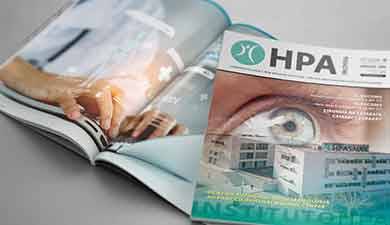Dr. Javier Gallego
Cardiothoracic Surgeon

Hyperhidrosis and facial flushing
Don’t be intimidated
HPA Magazine 9
Hyperhidrosis is an excessive and unnecessary increase in sweating that affects the hands, underarms and feet in a particular way.
Perspiration is a necessary function to control body temperature, and is regulated by the sympathetic system. However, for around 2.5% of the population this system does not function correctly, i.e. there is an excessive stimulus of the sweat glands and an intense production of sweat in certain parts of the body, a situation referred to as hyperhidrosis.
The most common and annoying form of hyperhidrosis affects the palms of the hands, which causes discomfort in social relationships (greeting with a handshake), as well as in work activities (handling electronic components, delicate merchandise, aesthetic treatments).
Axillary hyperhidrosis is also frequent and equally uncomfortable and embarrassing because it stains most clothing.

Plantar hyperhidrosis greatly restricts the daily life of patients, mainly in the choice of footwear and also because of the impossibility of using open shoes in the summer.
Craniofacial hyperhidrosis is excessive sweating of the face and scalp. This situation cannot be “disguised”, so there are people who stop doing certain everyday activities and many say that the situation has affected their professional growth.
Facial flushing can be related to an alteration of the autoimmune nervous system, provoking a facial erythema, also greatly limiting professional and social participation, as it creates insecurity when coming into contact with other people, and therefore the tendency to hide the problem.
MINIMALLY INVASIVE TREATMENT
The definitive treatment for hyperhidrosis is Bilateral Video-Assisted Thoracic Sympathectomy. It has been known for some time but until just a few years ago it was not possible to perform the surgery in a simple and minimally-invasive way.
Video-assisted and minimally invasive thoracic surgery revolutionised the treatment of hyperhidrosis by allowing the interruption of the sympathetic innervation in a select and definitive way, with a success rate of 98%, namely in the case of the hands and underarms.
The surgery is done with local anaesthesia, allowing the patient to go home on the same day and go back to work two days later.
HOW IS THE SURGERY DONE?
The surgical procedure consists of placing a small titanium clip that blocks the ganglia of the sympathetic nerve responsible for sweating in the zone in question, and immediately and definitively solves the problem of excessive sweating.
To place the clip, two tiny incisions are made under the armpits and, with a 3 or 5 mm endoscopic camera and minimally invasive surgery it is possible to access the nerve.
This technique is a recent solution that makes it possible to reverse the possible side effects of surgery which, in our experience, happen in fewer than 3% of the cases, as is the case of compensatory sweating.
ARE THERE ANY SIDE EFFECTS?
In a minimal percentage of patients (1-2%), so called compensatory hyperhidrosis can appear; a slight increase in sweating on the back and abdomen, normally well tolerated and substantially preferable to sweating hands and underarms. The fact of applying titanium clips means that in the case of compensatory hyperhidrosis, it can be reversed by removing the clips, meaning that this technique is “reversible surgery”.
ARE THERE ANY ALTERNATIVES TO SURGERY?
Botulinum toxin (Botox®) is an alternative treatment that is applied by local injections and has shown good results for isolated underarm sweating.
In order to assess the intensity and extension of underarm sweating, the Minor test is first done, and the sweating only disappears two days after injecting the toxin. This alternative to surgery is, however, not definitive, as it is necessary to repeat the Botox® because the hyperhidrosis will usually return six months later.
For craniofacial sweating, there is the possibility of applying a gel, made up in pharmacies but requiring a doctor’s prescription. In spite of also not being a definitive possibility, it does substantially improve the symptoms.
The specialised consultation for Hyperhidrosis and Facial Flushing is the responsibility of Professor Javier Gallego.











